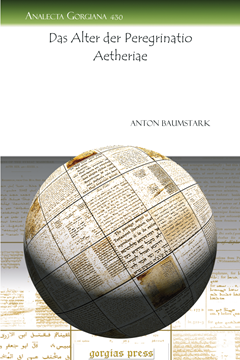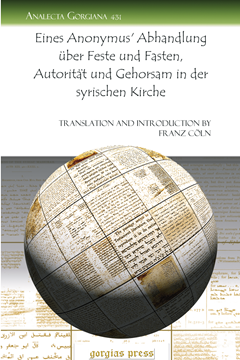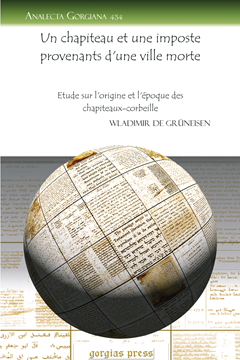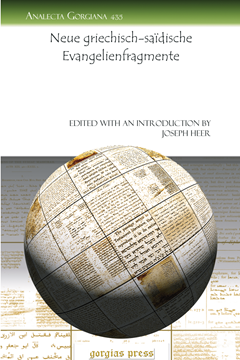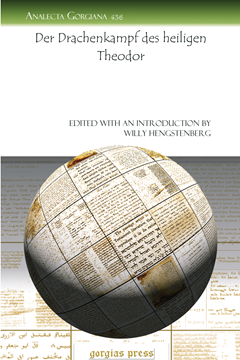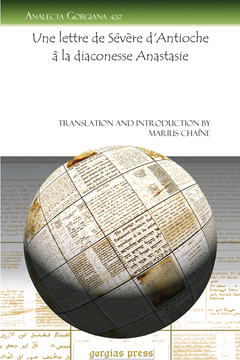Une autobiographie syriaque de Denys l'Aréopagite
Translation and Introduction by Marc-Antoine Kugener
Series: Analecta Gorgiana 429
ISBN: 978-1-60724-735-7
The “Autobiography” of Dionysius the (Pseudo-)Aereopagite exists in two separate recensions found in three manuscripts. Marc-Antoine Kugener publishes here the Syriac text of the two recensions along with an introduction and a German translation.
$43.00 (USD)
Das Alter der Peregrinatio Aetheriae
Series: Analecta Gorgiana 430
ISBN: 978-1-60724-736-4
Anton Baumstark discusses the critical issues in the dating of the text of the Peregrinatio of Egeria. After comparing the account with other texts, Baumstark concludes in favor of the traditional fourth-century date and provides needed support for this conclusion.
$41.00 (USD)
Eines Anonymus' Abhandlung über Feste und Fasten, Autorität und Gehorsam in der syrischen Kirche
Translation and Introduction by Franz Cöln
Series: Analecta Gorgiana 431
ISBN: 978-1-60724-737-1
Franz Cöln publishes here an anonymous treatise that deals with the topic of church authority from the perspective of the Syriac tradition. Cöln publishes the Arabic text of the treatise and includes a Latin translation and a brief introduction.
$41.00 (USD)
Vier geistliche Gedichte in syrischer und neusyrischer Sprache
aus den Berliner Handschriften Sachau 188 und 223 übersetzt und mit Einleitung versehen
Translation and Introduction by Bernhard Vandenhoff
Series: Analecta Gorgiana 432
ISBN: 978-1-60724-738-8
Bernhard Vandenhoff publishes here a German translation of three Neo-Aramaic poems and one Syriac poem. In the introduction to these translations, Vanderhoff discusses the dialects and provides an overview of the content of the poems.
$45.00 (USD)
Die Panoplia dogmatica des Euthymios Zigabenos
Untersuchung ihrer Anlage und ihrer Quellen, ihres Inhaltes und ihrer Bedeutung
Series: Analecta Gorgiana 433
ISBN: 978-1-60724-739-5
Jacob Wickert offers one of the most thorough discussions of Euthymios Zigabenus ever produced, including an introduction to his life and a detailed discussion of the contents of Euthymios’s compendium of heresies, the Panoplia Dogmatica.
$56.00 (USD)
India In 1500 AD
The Narratives of Joseph The Indian
ISBN: 978-1-60724-770-8
A critical study of the rare historical documents that lay behind the narratives of Joseph the Indian in the 1500s.
$173.00 (USD)
Un chapiteau et une imposte provenants d'une ville morte
Etude sur l'origine et l'époque des chapiteaux-corbeille
Series: Analecta Gorgiana 434
ISBN: 978-1-60724-771-5
Wladimir de Grüneisen surveys the history of the basket-design in art and architecture in the Greco-Roman world based on a column capital and transom discovered at Tusculum.
$40.00 (USD)
Neue griechisch-saïdische Evangelienfragmente
Edited with an Introduction by Joseph Heer
Series: Analecta Gorgiana 435
ISBN: 978-1-60724-772-2
Joseph Michael Heer discusses the philological, text-critical, and liturgical value of five parchment pages containing the resurrection narratives from the Gospels of Mark and Luke in parallel columns of Greek and Sahidic Coptic and provides a transcription of the texts.
$41.00 (USD)
Der Drachenkampf des heiligen Theodor
Edited with an Introduction by Willy Hengstenberg
Series: Analecta Gorgiana 436
ISBN: 978-1-60724-773-9
The ancient myth of a hero who slays a mythical beast worked its way into the lore of early Christianity. Willy Hengstenberg discusses here the sources for the dragon-slaying legend attributed to two separate fourth-century figures named Theodore.
$46.00 (USD)
Une lettre de Sévère d'Antioche à la diaconesse Anastasie
Translation and Introduction by Marius Chaîne
Series: Analecta Gorgiana 437
ISBN: 978-1-60724-774-6
Marius Chaîne publishes the Coptic text and French translation of a letter attributed to Severus of Antioch and addressed to the deaconess Anastasia. In the introduction, Chaîne discusses the attribution to Severus and the exegetical method displayed within the letter.
$37.00 (USD)

